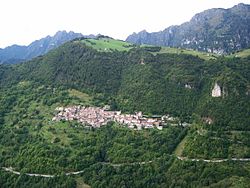Magasa, Lombardy
Comune in Lombardy, Italy From Wikipedia, the free encyclopedia
Comune in Lombardy, Italy From Wikipedia, the free encyclopedia
Magasa is a town and comune in the province of Brescia, in Lombardy in northern Italy.
Magasa | |
|---|---|
| Comune di Magasa | |
 | |
| Coordinates: 45°46′55″N 10°36′59″E | |
| Country | Italy |
| Region | Lombardy |
| Province | Brescia (BS) |
| Frazioni | Cadria, Cima Rest |
| Government | |
| • Mayor | Federico Venturini (Lista Civica) |
| Area | |
| • Total | 19 km2 (7 sq mi) |
| Elevation | 978 m (3,209 ft) |
| Population (2011)[2] | |
| • Total | 145 |
| • Density | 7.6/km2 (20/sq mi) |
| Demonym | Magasini |
| Time zone | UTC+1 (CET) |
| • Summer (DST) | UTC+2 (CEST) |
| Postal code | 25080 |
| Dialing code | 0365 |
| Patron saint | Sant'Antonio Abate |
| Saint day | 17 Gennaio |
| Website | Official website |
In position on the plateau of Denai, in the Valley of Vestino, inland of Lake of Garda, rises the small village of Magasa, whose origins go back to the Celtics; they called the place mag, the field. The Stoni and the Gallic Cenomani, then the Romans and the Lombards lived here. The Lodrone family established in Magasa from 1200 to 1807; then, for centuries, this has been nobody's land. It became part of Italy in 1919, Magasa was separated from Trentino in 1934, and became a hamlet of Turano.
The ancient administrative autonomy of 1589, was achieved again in 1947. The abundance of pastures has always been significant for the village economy. Dedicated to cattle raising which survives still today in summer mountain barns with production of milk, from which famous cheeses and butter are obtained. The historical core is a crossing of small passages with peasants' high and narrow houses; the church is dedicated to Sant'Antonio Abate, mid 18th century.[3]
Inside, the religious building is characterized by the floor in red and yellow stones from the Denervo mountain. The pleasant hamlet of Cadria is surrounded by a magic natural atmosphere; the people are proud of their small church of San Lorenzo. The church, of allegedly of Lombards origins, was restored in 1547 and is the pilgrimage arrival on occasion of the patron's day, 10 August. An ancient ritual is renewed, instituted by testament in 1588, with the distribution to every participant to the religious celebration of one piece of bread and fifth of wine.
Today, the village of Magasa is the owner of the church and it is morally engaged to comply with the original benefactor's desire to renew the tradition. The bright sky of Cima Rest, free from any pollution, has allowed the association Astrofili di Salò to arrange an Astronomical public observatory.
The straw-roofed haylofts of plateau Denai and Cima Rest are mentioned for the first time in a document dated 1613. Some historians have established a link between their constructive type and some low Middle Age constructions; other say that Lombards from Hungary built them in 600 a. D.
Their unique architecture is a true masterpiece of efficiency and economy. The steep roof in wheat straw is waterproof. In order not to lose the memory of the places and local culture, one of the haylofts of Cima Rest has become the Ethnographic Museum of the Valvestino.


Seamless Wikipedia browsing. On steroids.
Every time you click a link to Wikipedia, Wiktionary or Wikiquote in your browser's search results, it will show the modern Wikiwand interface.
Wikiwand extension is a five stars, simple, with minimum permission required to keep your browsing private, safe and transparent.